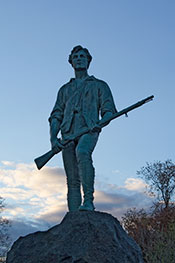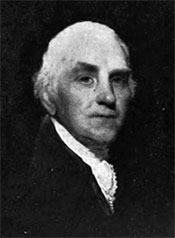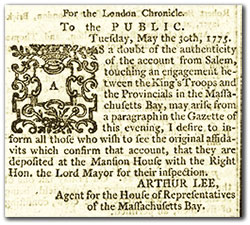Messenger of Revolution.
For most of us the American Revolution means the Declaration of Independence, George Washington, Paul Revere and some battles. But a lot happened behind the scenes — someone had to build and nurture our alliances, obtain weapons and promote the cause both among supporters and adversaries. In fact one of the rebellious colonists’ earliest victories was achieved in the battle for public opinion.1

The Atlantic World in 1775. We often think of 1770s Americans as living apart from Europe, but they saw themselves as part of an Atlantic community. Philadelphia was the second largest city in the British Empire,2 Americans went to England to study and pursued careers on both sides of the ocean. There was no United States — the cry no taxation without representation referred to representation in the British Parliament and colonial assemblies.3 Many colonists were steadfastly loyal to the Crown, only the most radical sought independence. Likewise many Britons were sympathetic to the colonists’ complaints, including members of Parliament and the nobility.
This was the setting in which the colonial militia confronted British regulars on Lexington Green in April 1775.
The Shot Heard Round the World. The events at Lexington and Concord marked a turning point in relations between the colonies and Britain — armed and organized opposition to the Crown was treason. The royal governor, General Thomas Gage, sent a report to London on April 24.

But in April 1775 Massachusetts had two governments. The elected provincial assembly that British authorities had dissolved in 1774 continued to operate as the Provincial Congress. On April 22 it met in Concord to decide on responses to the actions at Lexington and Concord.
Anxious that the world view the colonists as victims and not aggressors, they gathered depositions from everyone who had witnessed the fighting and decided to send those accounts to England. Richard Derby, a wealthy fleet owner and member of Congress, offered to provide a fast ship with one of his sons, John Derby, as captain. Derby was instructed to deliver the accounts to Massachusetts’ agents in London, Benjamin Franklin and Arthur Lee.
There was concern that Royal authorities would try to seize the dispatches, so Derby was instructed to tell no one, not even his crew, where they were going and to land in Ireland so as to avoid Royal Navy patrols off England. Speed was crucial so it was decided the ship would sail without the weight of cargo.

Derby’s ship was a small schooner, the Quero, that could be made ready quickly without arousing suspicion. When it departed on April 28, the first challenge was to evade British patrols around Salem. Familiar with the local waters, Derby did so easily and crossed the Atlantic in 29 days. He disregarded the orders to land in Ireland, presumably in the interest of speed, and proceeded to the Isle of Wight, where he disembarked and continued to London.
London Learns of Revolt. Derby arrived in London on May 28 and deposited his papers with the Lord Mayor of London, a colonial sympathizer. General Gage’s ship had not yet arrived so this was England’s first news of “the shot heard ’round the world.” Word spread quickly, fueled by rumors from other arriving vessels. Former Massachusetts Governor Thomas Hutchison, who was living in London at the time, noted in his diary that “[t]he opposition here rejoice that the Americans fight, after it had been generally said they would not.” Stocks fell and there was a general uneasiness.

Official London responded by cautioning that General Gage's official report had not yet arrived and characterizing Derby’s accounts as what today we might call “fake news.” Arthur Lee, the agent for Massachusetts, responded by publishing a notice in The London Chronicle inviting people to read the actual depositions at the Lord Mayor’s office. Some of the eyewitness accounts were also printed in the paper.
Lord Dartmouth, British Secretary for the Colonies, summoned Derby to explain his stories. But Derby seems to have snuck out of London as mysteriously as he had arrived for neither he nor his ship was anywhere to be found. General Gage’s report finally arrived on June 9 and essentially confirmed Derby’s news. Dismayed at its being so late, Dartmouth instructed that in the future Royal officials follow Derby’s example and send dispatches of importance by one of the fleet’s light vessels.
* * * * *
John Derby returned to Massachusetts and reported his adventures to George Washington in Cambridge. But his news that ordinary citizens could successfully stand up to those in authority spread far beyond England. From its initial appearance in London papers on May 29, it spread as far as Saint Petersburg by June 19.8
-----
- Information for this article is compiled from the following sources: Robert S. Rantoul, The Cruise of the Quero, Historical Collections of the Essex Institute, Vol. XXXVI, No. 1, p. 1 (1900); Todd Andrlik, Reporting the Revolutionary War, pp. 120–27 Sourcebooks (2012); Robert E. Peabody, Merchant Venturers of Old Salem, Chapter II, Houghton Mifflin Company (1912).
- Office of the Historian, U.S. State Department, Buildings of the Department of State.
- Article on No Taxation without Representation in Wikipedia.
- Statue by Henry Hudson Kitson on Lexington Green.
- John Derby, from an 1809 painting by Gilbert Stuart. Image from Robert Peabody, Merchant Venturers of Old Salem, p. 36, Houghton Mifflin Company (1912).
- Model of eighteenth century schooner built in New England, possibly similar to the Quero. Model is in the collection of the Smithsonian Institution. Image from Smithsonian’s web site.
- Notice from page 1 of The London Chronicle for May 30 to June 1, 1775. Image from Before History web site.
- Henry Fairlie, What Europeans Thought of Our Revolution, The New Republic. Originally published July 18, 1988, published on-line July 4, 2014.
This article originally appeared in our free semi-monthly newsletter. To receive future issues, please add your name to the subscription list.

